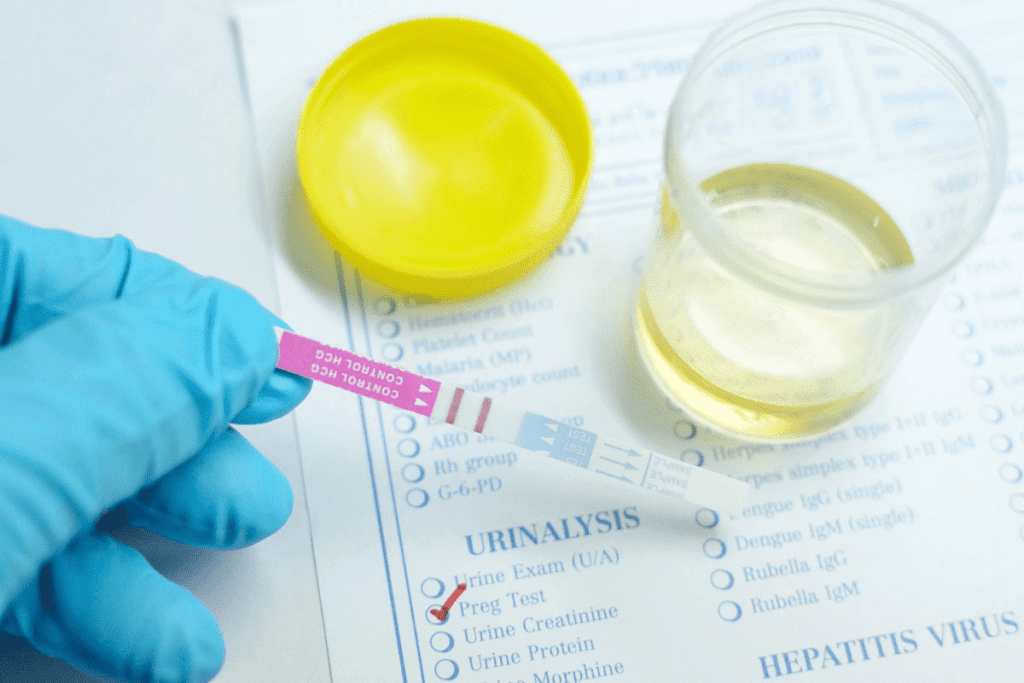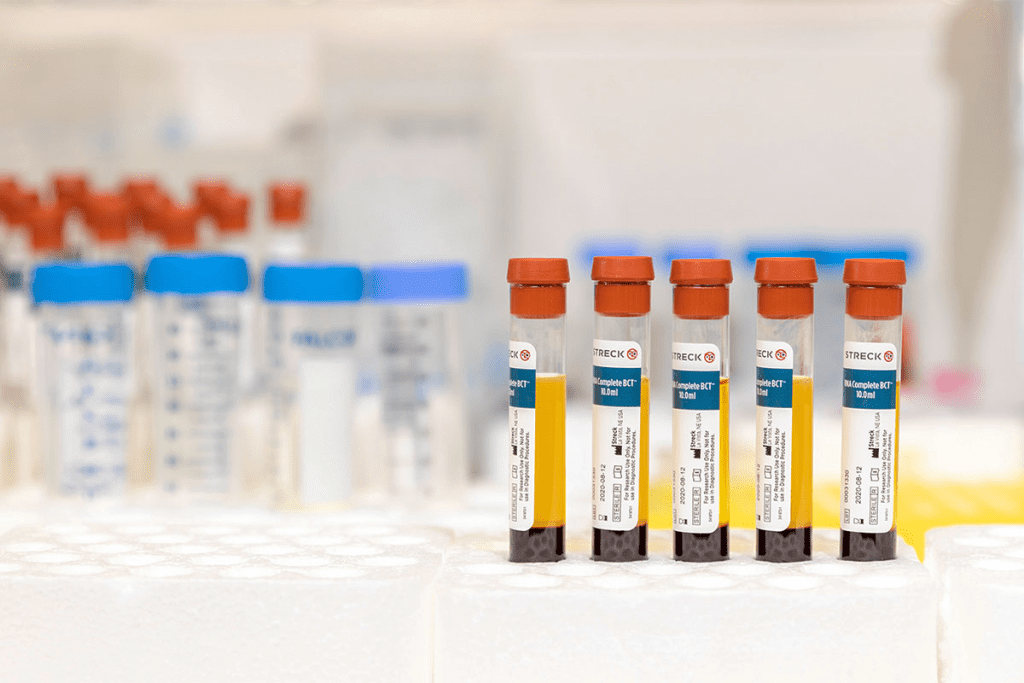Last Updated on November 25, 2025 by
A ‘bad’ result often involves high bacteria, blood, or elevated leukocyte esterase. Learn what these abnormal markers indicate.
A bad urinalysis result can mean you might have a urinary tract infection or kidney disease. This test helps us find and manage many health problems.

When urinalysis shows something’s off, we need to do more tests to figure out why. Knowing what a bad result means is key to catching health problems early.
At Liv Hospital, we aim to give top-notch healthcare and support. A bad urinalysis might show issues like proteinuria, hematuria, or leukocyturia. These could mean infections or other big health problems.
A urinalysis test checks the look, amount, and what’s in your urine. It helps find health problems like infections, kidney disease, or metabolic disorders.

When you get a urinalysis, they look at your urine’s color, clarity, and specific gravity. If your urine looks cloudy, it might mean you have a urinary tract infection. The specific gravity shows how well your kidneys are working.
They also check your urine’s pH, protein, glucose, ketones, and leukocyte esterase. The presence of leukocyte esterase means you might have a urinary tract infection. The National Center for Biotechnology Information says knowing these values is key to diagnosing many conditions.
They look at your urine under a microscope for red blood cells, white blood cells, bacteria, and casts. Seeing white blood cells (WBC) or leukocytes in your urine means you might have an infection or inflammation. A lot of WBCs could mean you need more tests to find out why.
In short, a urinalysis test is a detailed tool for checking your health. It looks at your urine’s physical, chemical, and microscopic aspects. Knowing what this test does helps doctors make better choices for your care.
Understanding abnormal urinalysis results is key to identifying and managing underlying health issues. When we receive a bad urinalysis result, it’s often a sign of an underlying condition that requires medical attention.
Proteinuria, or the presence of protein in the urine, can be a sign of kidney disease or damage. Normally, kidneys filter waste while retaining essential proteins. But when kidneys are damaged, they may fail to filter properly, leading to protein leakage into the urine.
Key implications of proteinuria include:
Hematuria refers to the presence of blood in the urine, which can be a sign of various underlying conditions. It can be categorized into microscopic hematuria (visible only under a microscope) or gross hematuria (visible to the naked eye).
Causes of hematuria include:
Leukocyturia indicates the presence of white blood cells in the urine, often suggesting an infection or inflammation within the urinary tract. The presence of leukocyte esterase, an enzyme produced by white blood cells, can also indicate leukocyturia.
Conditions associated with leukocyturia include:
Testing positive for leukocyte esterase in urine or WBC esterase in urine can be a critical indicator of these conditions.
A positive nitrite test in urinalysis often indicates the presence of bacteria that convert nitrate to nitrite. This is commonly seen in urinary tract infections.
Implications of positive nitrites include:
Understanding these abnormal findings, including UA leuk est and urine wbc, is key to diagnosing and managing urinary tract infections and other related conditions.

Leukocyte esterase is a key indicator in urinalysis. It shows the presence of white blood cells in urine. This enzyme is made by white blood cells, and its presence can mean an infection, like a urinary tract infection (UTI).
Leukocyte esterase in urine often means an infection. White blood cells in urine show the body is fighting an infection in the urinary tract. This can be caused by bacteria, fungi, or other pathogens.
Key points to consider:
The amount of leukocyte esterase in urine can vary. Understanding these levels is key for accurate diagnosis. A higher level usually means a higher chance of infection.
It’s essential to understand that:
A positive leukocyte esterase test can be linked to several medical conditions. Mainly, it’s seen in urinary tract infections. But it can also show up in other conditions that cause inflammation or infection in the urinary tract.
“A positive leukocyte esterase test should be interpreted in the context of the patient’s overall clinical presentation and other laboratory findings.”-Experts highlight.
Some conditions linked to a positive leukocyte esterase include:
It’s important to know about the challenges in urinalysis accuracy for good patient care. Urinalysis is a common tool that gives insights into a patient’s health. But its results can be tricky due to several factors. So, we need to be careful when we look at these results.
The sensitivity of a urinalysis test shows how well it finds people with a disease. The specificity shows how well it finds people without a disease. Urinalysis has a sensitivity of 81%, which is good for finding some conditions. But, its specificity is only 54%, leading to many false positives.
When we look at urinalysis results, we must remember these numbers. A test with high sensitivity but low specificity can cause worry and extra tests for people who don’t really have a problem.
False positives happen when a test says you have a condition when you don’t. Urinalysis has a false-positive rate of 46%, meaning almost half of its positive results are wrong. This shows we need to be careful and might need more tests to be sure.
A positive leukocyte esterase (UA leuk est) test might not always mean you have an infection. Things like contamination or some medicines can affect the results.
Many things can mess with urinalysis results, including:
Knowing about these factors is key for healthcare providers. It helps them understand urinalysis results better and make the right decisions for treatment.
In short, while urinalysis is useful, we must know its limits. By understanding its accuracy challenges, we can give better care to our patients.
Abnormal urinalysis results can show serious health issues that need quick medical care. Urinalysis checks urine for physical, chemical, and microscopic signs of health problems.
Urinary tract infections (UTIs) are common and can be found through urinalysis. The presence of leukocyte esterase in urine and urine WBC (white blood cells) means a UTI might be present. Leukocyte esterase is an enzyme from white blood cells, indicating an infection.
But UTIs can be complex, with different bacteria or issues like catheter infections. Advanced urinalysis can find the bacteria causing the infection, helping choose the right antibiotics. It’s important to treat UTIs to avoid kidney damage or sepsis.
Kidney disease can be shown by abnormal urinalysis results. Signs like proteinuria (protein in urine) or hematuria (blood in urine) mean kidney damage or disease might be starting. Chronic kidney disease (CKD) can get worse if not managed well.
Urinalysis can also find kidney problems like casts or epithelial cells in urine. These show tubular damage or other kidney issues.
Diabetes is often found through urinalysis, showing glucosuria (glucose in urine). Glucose in urine means diabetes or pre-diabetes. Urinalysis also tracks diabetes’s effects on the kidneys.
Other metabolic disorders, like kidney stones or mineral metabolism disorders, can be found in urinalysis. For example, certain crystals in urine might mean a risk for kidney stones.
Liver disease can be hinted at by abnormal urinalysis results. For instance, bilirubin in urine can show liver problems or bile duct blockage. Urinalysis helps find liver issues early, leading to more tests.
In conclusion, bad urinalysis results can point to serious health issues. It’s key to understand these results to catch diseases early and manage them well.
Our understanding of urinary tract infections (UTIs) is growing. This means we’re changing how we read urinalysis results. New studies show we need to rethink how we interpret these tests.
Research shows E. coli is now less common in UTIs, making up less than 60% of cases. Clinical experience shows this change. It means we’re seeing more diverse pathogens, making E. coli less reliable as a single indicator.
New pathogens are making urinalysis tests less accurate. We need new ways to detect these pathogens. This requires a deeper understanding of UTI-causing bacteria.
New detection methods are being developed. These include more sensitive tests and molecular diagnostics. These advancements will help us detect UTIs more accurately.
We’re moving towards a deeper understanding of urinalysis results. This includes considering the complex interactions of various pathogens and markers. This shift will lead to better care and more precise treatments for patients.
Understanding your urinalysis results is key to spotting health issues early. We’ve looked at what a urinalysis test covers, like physical and chemical tests, and what you can see under a microscope.
Leukocyte esterase in your urine is a big clue. It shows white blood cells, which might mean you have a urinary tract infection. But it’s important to look at your results as part of your whole health picture.
If you’re wondering about your test results, talk to your doctor. They can explain what your results mean and what to do next.
Getting the most out of your urinalysis results can help you stay healthy. It’s not just a urine test. It’s a way to see how your body is doing overall.
A positive leukocyte esterase test shows white blood cells in your urine. This can mean you have a urinary tract infection or another health issue.
Leukocyte esterase is key in urinalysis. It helps find urinary tract infections and other issues by spotting white blood cells in your urine.
Bad urinalysis results often show proteinuria, hematuria, leukocyturia, and positive nitrites. These signs can point to infections, kidney disease, or other health problems.
Urinalysis helps spot kidney disease by looking for proteinuria and hematuria. These signs can show kidney damage or disease.
Things like contamination, certain medicines, and health conditions can mess up urinalysis results. This can lead to false positives or negatives.
Sensitivity means the test catches true positives. Specificity means it catches true negatives. Leukocyte esterase has a sensitivity of 81% and specificity of 54%.
Yes, urinalysis can find diabetes and metabolic disorders. It looks for glucose in your urine, which can show these conditions.
E. coli infections in urinary tract infections have dropped. Now, less than 60% of cases are E. coli. Other pathogens are becoming more common.
New pathogens can mess up urinalysis test accuracy. This might cause false negatives or positives. Tests need to adapt to these changes.
New detection methods are being developed to make urinalysis more accurate. They help find urinary tract infections and other issues better.
Epithelial cells in urine can mean a urinary tract infection or another health problem. More tests might be needed to find the cause.
Leukocyte esterase helps find urinary tract infections by looking for white blood cells in your urine. This is a common sign of infection.
White blood cells in urine, or leukocyturia, can show a urinary tract infection or another issue. More tests might be needed to find the cause.
Urinalysis can spot liver disease by finding bilirubin in your urine. This can show liver problems.
The Sensitivity and Specificity of White Blood Cells and Nitrite in Dipstick Urinalysis. https://www.ncbi.nlm.nih.gov/pmc/articles/PMC8253458/
“Urinalysis: A Comprehensive Review. (2005). American Family Physician.https://www.aafp.org/pubs/afp/issues/2005/0315/p1153.html
Subscribe to our e-newsletter to stay informed about the latest innovations in the world of health and exclusive offers!